The Thorn Line of Coasters
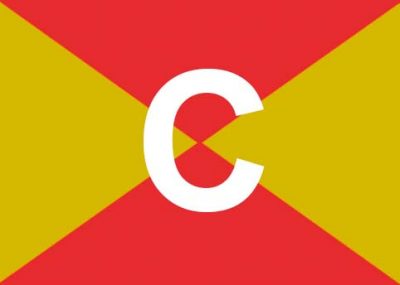
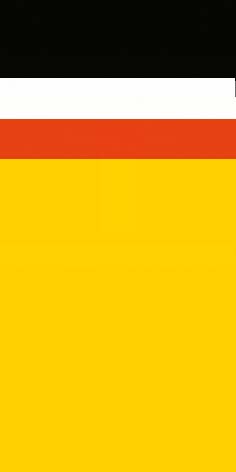 Samuel William Coe was of Norfolk descent and was working in a partnership with William James Ireland at the start of World War I as ship and insurance brokers in Liverpool. The partnership between the two young men was however dissolved by mutual consent on 31st October 1915. William James Ireland continued in business at 716 Tower Buildings at 22 Water Street in Liverpool, taking over all debts due and money owing to or by the partnership. All manner of types of vessel were sold or purchased during the war by William James Ireland, including the three masted sailing ship Cimbri of 99.5 feet in length and built in 1877 at Barnstaple for Guernsey registry. The quarterdeck engines aft steam coaster Redstone, completed by A. Jeffrey & Company at Alloa in 1916, was purchased at the end of 1917 and sold on to J. B. Kee of the Ramsey Steamship Company and renamed as Ben Vooar as the fourth steamer in his fledgling fleet. ‘Vooar’ in the Isle of Man dialect means ‘woman’.
Samuel William Coe was of Norfolk descent and was working in a partnership with William James Ireland at the start of World War I as ship and insurance brokers in Liverpool. The partnership between the two young men was however dissolved by mutual consent on 31st October 1915. William James Ireland continued in business at 716 Tower Buildings at 22 Water Street in Liverpool, taking over all debts due and money owing to or by the partnership. All manner of types of vessel were sold or purchased during the war by William James Ireland, including the three masted sailing ship Cimbri of 99.5 feet in length and built in 1877 at Barnstaple for Guernsey registry. The quarterdeck engines aft steam coaster Redstone, completed by A. Jeffrey & Company at Alloa in 1916, was purchased at the end of 1917 and sold on to J. B. Kee of the Ramsey Steamship Company and renamed as Ben Vooar as the fourth steamer in his fledgling fleet. ‘Vooar’ in the Isle of Man dialect means ‘woman’.
The transition by a shipbroker into a shipowner is not an easy one, as one has to take into account the cargoes, crews, capital and maintenance costs that have to be found. Thus, it was not until 1923 that William James Ireland felt in a strong enough position to become a shipowner, trading the steam coaster Hawthorn of 298 grt in the Irish Sea trades to Northern Ireland and the stone trade from North Wales quarries. The vessel had been completed in July 1903 by George Brown & Company of Greenock as a quarterdecker with a quarterdeck of length fifty five feet on a hull length of 130.2 feet and a beam of 24.1 feet. She had a well deck forward just aft of fo’c’stle of length eighteen feet, with a service speed of eight knots from a triple expansion steam engine by Muir & Houston of Glasgow. The steam coaster Oak Villa, the former Norwood, of 222 grt and completed in 1902, was also purchased by William James Ireland in 1923.
The Gateshead built quarterdeck steam coaster Deux Freres of 439 grt, completed by Wood, Skinner in 1908, was purchased in 1924 and renamed Silverthorn. She was of length 150.0 feet with a beam of 25.1 feet and was powered by a triple expansion steam engine built on the Tyne by the North Eastern Marine Engineering Co. Ltd. She was sold in 1927 and repurchased in 1938 and then sold on again in 1942. The steam coaster Celtic Pride of 456 grt was purchased in 1925 and renamed Briarthorn, and had been completed in January 1910 by A. Hall & Company of Aberdeen. She had a quarterdeck of length ninety feet on a hull length of 155.3 feet and a beam of 25.2 feet, with a well deck forward and a compound two cylinder steam engine supplied by her builder. The Rix of Hull steam coaster Spurnpoint of 235 grt and completed in 1908 was purchased in 1927 and renamed Quickthorn, but was sold on in 1931 and renamed Dunavon.
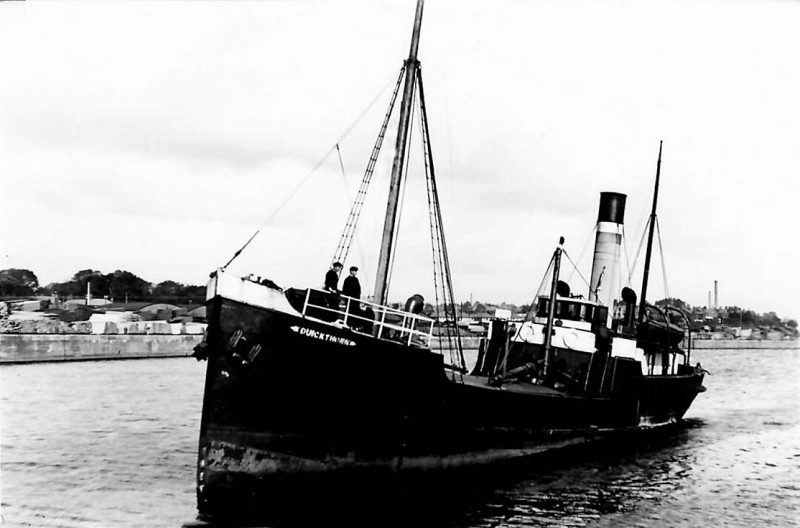
The fleet saw a quick turnover of small coasters in the inter-war years, with three purchased during 1930/32 as Eastoft of 306 grt, completed in 1900 and later renamed Whitethorn, and the coaster Reedness of 291 grt completed in 1903 by John Shearer & Sons of Kelvinhaugh on the Clyde, and with a long career behind her with DFDS of Denmark from 1907 to 1923 as Bogo. The Isle of Man Steam Packet Co. Ltd. steam coaster Tyrconnel of 276 grt built back in 1892 completed this purchased trio in the early 1930s. The fleet in 1933 was five coasters in Hawthorn, Briarthorn, Eastoft (renamed Whitethorn in 1936 and broken up in 1938), Reedness (renamed Redthorn in 1936 and wrecked at Coleraine on 21st November 1938 while on a voyage from Garston to Coleraine with coal), and Tyrconnel (broken up in 1933). The steam coaster Pulteney of 358 grt had been completed as Barrow Castle in 1899 by the Ailsa yard, and was purchased later in 1933 as a replacement but was sunk by collision on 18th August 1934 off Bardsey Island while on a voyage from the quarry at Penmaenmawr to London with stone. Further purchases were the coaster Virago of 321 grt, completed as Javelin in 1905 and renamed Firethorn, the coaster Porthleven of 342 grt completed in 1903 as Taunton but with a long career with A.F. Henry & MacGregor of Leith as St. Abbs Head, and the coaster Rosyth of 439 grt and renamed Quickthorn (2). Thorn Line Ltd. was registered in 1936 with the first steamer Hawthorn 298/03 as the first coaster of the new company.
The Ribble Shipping Co. Ltd. was taken over in 1937 together with the steam coasters Ribblebank 351/21 and Carlingford 345/08. The company had been formed by John S. Sellers back in 1904, with William James Ireland subsequently registering several other coasters under this company, and which continued being managed from his Liverpool office in post-war years. The ‘Thorn’ fleet in 1937 was now one of eight steam coasters in Firethorn, Quickthorn, Silverthorn, Briarthorn, Hawthorn, Redthorn, Whitethorn and Porthleven, with four registered under Thorn Line Ltd.
Two sister coasters from the Rix fleet of Hull were purchased in 1939 in Jarrix of 417 grt renamed Gorsethorn, and Ebbrix renamed Bannthorn. The sisters were products of the Cochrane & Sons yard at Selby in 1917 with quarterdecks of length 86 feet on a hull length of 158.7 feet and a beam of 24.6 feet. The pair had triple expansion steam engines from the Shields Engineering and Dry Dock Co. Ltd. situated next to North Shields Fish Quay. They were given the yellow funnel with a black top separated by white over red bands of the rest of the Thorn Line fleet instead of the red Rix funnel. The coaster J.F.V. of 515 grt built in 1909 as Wheatfield by J. T. Eltringham & Company at South Shields for Spillers and Bakers Ltd. of Cardiff was also purchased in 1939.
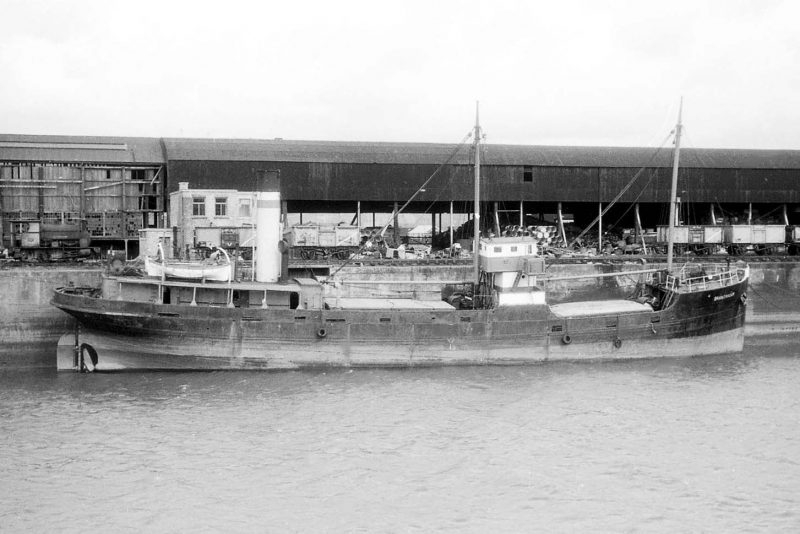
World War II
The fleet of eight coasters on the outbreak of war on 3rd September 1939 (J.F.V., Bannthorn, Gorsethorn, Carlingford, Quickthorn, Ribblebank, Firethorn and Silverthorn) continued on their regular general cargo service between Liverpool and Coleraine, as well as carrying coal to most other Irish ports. The first coaster in the fleet, Hawthorn purchased in 1923, had been sold in 1939 to H. S. Cordran with her registry changed from Hull to London, and she survived the war. Four of the fleet became marine losses:-
- Gorsethorn foundered off the Mersey Bar on 8th December 1940 while on a voyage from Preston to Cork with coal.
- Quickthorn capsized off Skokholm Island on 15th January 1942 and sank while on a voyage from Newport to Londonderry with coal, her crew were fortunately saved.
- Thelma of 400 grt built back in 1903 for the Zillah Shipping and Carrying Company of Liverpool was purchased in 1943, but was wrecked on 12th July 1943 on the west end of Doolough Point, Blacksod Bay while on a voyage from Ayr to Galway in ballast. She was later refloated on 7th December 1943 but sank soon afterwards.
- Knowl Grove of 370 grt completed in March 1909 by J.P. Rennoldson at South Shields for the Goole and Hull Steam Towing Co. Ltd. of Goole was purchased in 1941 but wrecked on 12th October 1943 in the river Bann while on a voyage from Maryport to Coleraine with coal.
Coasters continued to be purchased and sold by William James Ireland throughout the war, including Burrington Combe of 462 grt built as Bellavale for John Kelly Ltd. back in 1910 by Mackie & Thomson of Govan, and she was owned during 1940/45 and then sold on to a Fraserburgh owner, and Overton of 426 grt built on the Tyne in 1911 by J. T. Eltringham at South Shields. Overton was purchased in 1941 and registered under H. Harrison (Shipping) Ltd., with the management taken over by William James Ireland at that time of this old firm founded in 1880 as John Harrison Ltd. The coaster Slateford of 355 grt was purchased in 1944, having been built in 1903 by R. Williamson & Son of Workington for Mann, MacNeal & Company of Glasgow. The coaster Victor of 435 grt built in 1907 by James Shearer & Sons of Glasgow was also purchased in 1944 and served until sold in 1948. Despite, these purchases, the company ended the war with half of the fleet that it had begun the war in Overton, Slateford, Ribblebank and Victor. The coaster Southport was then purchased in 1946 and sold on a year later.
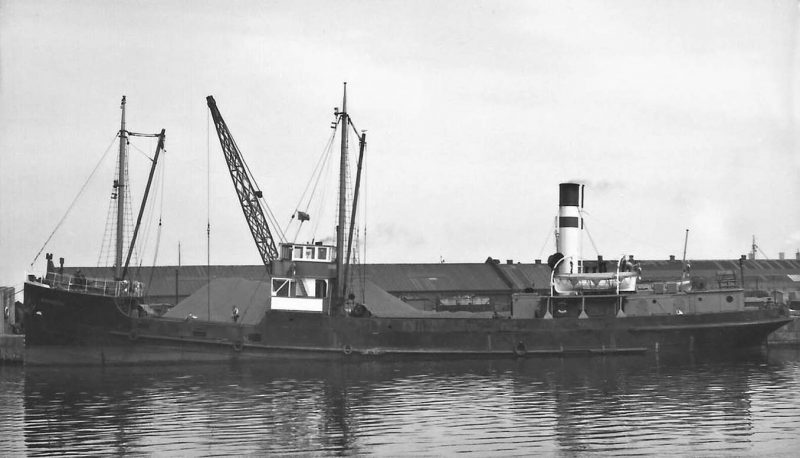
Post-War Years
A change of ownership was made in 1948 to Cyril G. Abel, who had joined the company office in 1923, and he then retained the fleet under the management of S. William Coe & Co. Ltd., with half of the fleet registered under Thorn Line Ltd. and the other half under H. Harrison (Shipping) Ltd. This fleet in 1950 numbered eight coasters in Bannbridge of 365 grt, Bannmaid (ex Slateford), Bannqueen of 515 grt (ex J.F.V.), Banntrader of 489 grt, Bannthorn of 429 grt, Overton of 426 grt, Ribblebank of 351 grt and Silverthorn of 436 grt. Bannqueen had been built on the Tyne by J. T. Eltringham at South Shields in 1909 as Wheatfield and was renamed J.F.V. in 1926, and Bannbridge had also been built on the coaly Tyne by J. & D. Morris at Newcastle as Rivelin in 1919 and was broken up at Preston in March 1951. Banntrader had been built as Beauly Firth in 1920 by J. Lewis & Sons Ltd. at Aberdeen for management by G. T. Gillie & Blair Ltd. of Newcastle, and became the last steam coaster in the Coe fleet when she was sold for breaking up at Preston in August 1962.
The nomenclature of a prefix of ‘Bann’, named after the river Bann that flows through the port of Coleraine and the destination of most of the fleet cargoes, was extended to more purchased steam coasters in the 1950s. The former Cromarty Firth of 377 grt, built in 1924 but sold in 1935 and renamed Cragsman, was purchased in 1951 and renamed Bannrose, serving until she arrived for breaking up at Preston on 15th February 1953. Bannrose (2) of 489 grt was purchased in 1954 and had been built as Ribblemere in 1925 by John Lewis & Co. Ltd. of Aberdeen, and was sold in 1930 for £11,500 to a Cardiff buyer and renamed Holburn Head. Bannrose (2) gave seven years of service until broken up in August 1961 at Woudrichem in Holland.
Two coasters came from the Gem Line fleet of William Robertson Shipowners Ltd. of Glasgow in Bannpride of 500 grt (ex Pyrope of 1936) and Bannprince of 569 grt (ex Tourmaline but completed in 1933 as Deemount). Bannpride was sold on to Italian owners in 1961, but Bannprince sank in the Mersey on 12th November 1955 after a collision with the Swedish tanker Juno. Second Engineer James Ferris from Northern Ireland later sadly died from the effects of immersion. Bannprince was raised two weeks later and beached at Wallasey and scrapped at Hendrik Ido Ambacht in Holland in April 1956. Bannquest of 362 grt was purchased in 1955 from the Newry fleet of Joseph Fisher & Sons as Opepe of 1937 and arrived for breaking up at Boom on 8th April 1958, and Bannspur of 488 grt was purchased in 1958 and had been built as Oriole in 1921 by John Lewis & Sons Ltd. for the General Steam Navigation Co. Ltd.
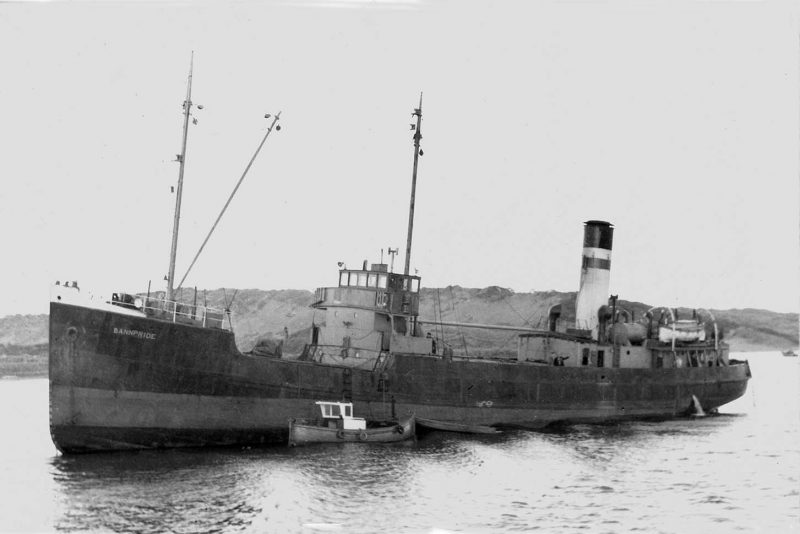
Booker Line Take-Over
The Coe coaster fleet was taken over by Booker Line of Liverpool in 1955 with a view to both British and coastal British Guiana trading in South America. Five of the Coe fleet were later bareboat chartered to Bookers Shipping (Demerara) Ltd. as Booker Trader (built as Julia Anna at Foxhol in 1956), Booker Trident, Booker Tide (built as Keizersveer at Alphen in 1957), Booker Trojan (built as Nore at Groningen in 1956) and Booker Talisman (built as Ria at Terneuzen in 1960) for coastal sugar shipments from outlying plantations into Demerara. The advent of the motor coaster into the Coe fleet made the long voyages out to Guiana and their later return voyages possible, and was long overdue in 1958 when Silverthorn of 496 grt entered service from the Unie Scheepswerft (United Shipbuilders) yard at Groningen. Silverthorn became Booker Trident in 1968, and was sold to the Guyana National Shipping Company in 1977, and renamed Guy Trident in 1979, becoming a total loss in the Caribbean in 2010.

Blackthorn of 749 grt became the second motor coaster in the Coe fleet in early 1960 on delivery from the N.V. Scheepswerft Westerbroek yard, having been launched on 30th December 1959. She was sold in 1976 and renamed Rudyard and sunk as an artificial reef off Oranjestad in Aruba in January 1988 as Jane Sea. Silverthorn and Blackthorn were given pale green hulls with dark green boot topping, as was the third motor coaster, Maythorn of 771 grt and 1,120 dwt, completed in 1962 by the Westerbroek yard. Maythorn was later lengthened to 899 grt and 1,366 dwt and continued trading around the British coasts until laid up at Hull in February 1984 as Wilgo for Wilship Maritime Services of Barrow on Humber, and she was broken up a year later at Zumaya in Spain.

Firethorn was completed by the J. Pattje yard at Waterhuizen in 1967 as a motor coaster of 1,041 grt and 1,725 dwt, and continued trading around the British coasts after her sale from the Coe fleet as Firestorm in 1989. The next Coe motor coaster was purchased second hand in 1968 and renamed Hawthorn of 1,375 dwt, and had been completed as Irish Heather in 1952 by the Goole Shipbuilding and Repairing Co. Ltd. for Irish Shipping Ltd. She had her bridge placed ‘midships and her British Polar diesels aft, and was a raised quarterdecker with two masts and derricks for cargo handling. In 1973, she was sold to Irish owners and renamed Howth Trader and later sailed out to Karachi as Al Akber.
The Dutch built motor coaster Oranmore of 472 grt was purchased in 1970 from the Limerick Steamship Co. Ltd. and renamed Redthorn in unusual circumstances. She had been in trouble in February 1970 just south of the Shannon estuary after her engines had broken down off Kerry Head, and after five days of storm, her anchor cable snapped and the ship drifted southward and grounded on Banna strand. The crew were rescued by the Valentia lifeboat but unfortunately one man unfortunately died in the process. The Dutch tug Friesland refloated her ten days later and towed her to Cork. After repairs to her damage, she was sold to Coe to give three years of service before her sale to Greeks and her new name of Maritasia. She was later wrecked on 11th July 1984 off Petalidi on Ios Island in the Aegean, and was broken up at Eleusis in June 1985 after refloating.
Tanmerack of 2,482 dwt was completed in 1967 by the Ailsa yard for a P. & O. subsidiary and managed by the General Steam Navigation Co. Ltd. for a Canadian timber charter to CP Ships. She was sold to Coe in 1973 and renamed Quickthorn for U.K. and Continental trading, and was joined in the same year by Briarthorn of 2,085 dwt, the former Anne Bogelund completed by E. J. Smit & Zoon at Westerbroek in August 1962 for Otto Danielsen of Denmark. The latter ship was converted into a drilling ship in 1978, and was sold to Wimpey Marine of London in 1981 and renamed Geodrill until sold for demolition five years later.

Rosethorn of 1,554 dwt was purchased in 1974 as Yewkyle from John Stewart & Co. Ltd. of Glasgow, but had been completed in 1960 as Laksa for Christian Salvesen, while fleetmate Yewhill of 1,390 dwt had been completed by the J. Lamont yard at Port Glasgow in 1957 and was renamed Silverthorn in 1974 after purchase. Whitethorn of 2,444 dwt was completed as Hero for the Bristol Steam Navigation Company by the Charles Hill yard at Bristol, and sold to Coe in 1970 and converted in 1975 into a drillship with a drilling platform and mooring anchors on charter to the National Environment Research Council. She continued after sale by Coe as a drillship until she was broken up at Gadani Beach in November 2002. Gorsethorn of 2,023 dwt was also completed for the Bristol Steam Navigation Company by the J. Pattije yard at Waterhuizen as Dido, and was sold to Coe in 1977 for conversion into a geophysical survey ship but was laid up in Vittoria Dock at Birkenhead in 1982. She was converted in 1990 into a radio ship named Deese de la Democratie, but was arrested in Taiwan and broken up there in September 2003. Hawthorn of 1,735 dwt had been completed in 1967 as Ortrud Muller at Elmshorn and was purchased in 1977, and she continued trading around the British coasts until her sale in 1992, latterly with a red hull.
Coe funnel colours during the Booker ownership had been changed to a blue funnel with a central white band bearing a red ‘C’, in line with Booker blue funnel colours with a central white band bearing a red ‘B’.

Coe Metcalf Shipping Ltd.
Booker Line had purchased Metcalf Motor Coasters, dating from 1924, in 1972 to further expand its coastal trading activities. The Coe and Metcalf subsidiaries were merged together and restyled by Booker in 1977 as Coe Metcalf Shipping Ltd. with a big fleet of seventeen coasters. Nine vessels came from the Coe fleet, and seven from the mixed dry cargo and coastal tanker fleet of Metcalf, together with one small water tanker, Aqua. The biggest vessel to be added to the fleet was Pholas of 3,775 grt and 4,000 dwt, which was completed by the Caledon yard in Dundee as the newsprint carrier Elizabeth Bowater for the Bowater Steamship Co. Ltd. in 1958. She was sold to Wimpey Marine for charter to the National Coal Board in 1972 and renamed Wimpey Sealab for coal coring work off the Durham coast, and then joined the Coe Metcalf fleet in 1980 as the red hulled Pholas as a self positioning drillship.
Briarthorn worked as a drill ship off Australia, and she and Gorsethorn also briefly had red hulls to work with Pholas in the English Channel on undersea cable laying and Channel Tunnel core sampling work in 1980. Oil drilling charters were obtained by the Coe fleet of drillships from American oil majors, with the red hulled Pholas drilling off Port Hueneme, Ventura (California) in 1981, arriving back from this charter to Barrow in February 1982. She then sailed for Newfoundland for the 1982 drilling season off the Grand Banks from bases at Halifax (NS) and St. John’s (NFL), she also drilled in the North Sea oilfields during 1983/84 from a base at Hartlepool on charter to Statoil, and then sailed from Hull to India via Suez in 1985 for another drilling charter, arriving back in the Tyne. Pholas worked continuously in the offshore oil and construction industries, based in St. John’s (NFL) in the 1988 season, and based in Malta for Mediterranean drilling in 1992, with also much North Sea drilling until sold in 1995 to DSND Shipping of Norway. She was fitted with a new dynamic positioning system for North Sea work and renamed Norskald until broken up in 2002.

The Coe Metcalf Shipping Ltd. fleet was thus an attractive one in 1984 in that it combined lucrative drilling contracts with dry cargo trading and coastal tanker trading. James Fisher and Sons Ltd. of Barrow were very keen to move into the coastal oil shipment fields as well as oil drilling from their traditional base of dry cargo coasters, and purchased Coe Metcalf Shipping Ltd. for £1.4 million from Booker Line in 1984. Five coastal tankers, four dry cargo coasters employed in the Irish Sea and Continental trades, and three drillships joined the Barrow company. Coe Metcalf Shipping Ltd. was later integrated within James Fisher and Sons Ltd. in 1995 as James Fisher and Sons (Liverpool) Ltd.
James Fisher and Sons Ltd. had also taken the opportunity to rename some of their dry cargo fleet with the traditional Thorn Line nomenclature. The coaster Eden Fisher had been completed in 1965 for the Barrow fleet and was sold on to new owners in 1979, but returned to the Fisher fleet in 1984 after repurchase and renaming as Blackthorn for a further year of service until sold again in 1985. The Fisher owned coasters Shamrock Endeavour and Shamrock Enterprise built in 1982 were renamed as Rosethorn and Silverthorn respectively in 1990, and two further acquisitions in 1990, Craigallian of 1980 and Pinewood of 1978, were renamed Briarthorn and Redthorn respectively. Briarthorn collided with the dredger Arco Severn in Newhaven harbour on 20th December 1996 at the end of a voyage from Llanddulas with stone. This quartet had resurrected the traditional Coe ‘thorn’ nomenclature throughout the 1990s until they were sold off after the Millennium by 2003. Thus, the Coe nomenclature had been seen in British ports and around British coasts for a period of eighty years from 1923 to 2003.
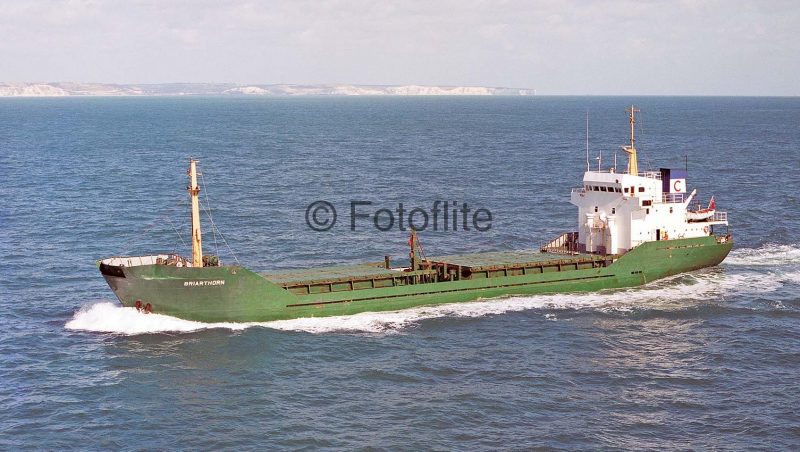
Postscript
The Coe and Coe Metcalf coasting fleets were well known to British crews and coaster enthusiasts, with the fleet totalling over seventy vessels in a complex history of ownership. The steam coasters with black hulls and yellow funnels with a black top separated by white over red bands had given way to a modern motor coaster fleet of pale green hulls with dark green boot topping and dark blue funnels with a central white band bearing a red ‘C’ for Coe. The hull, P. & I. cargo risks and war risks insurance for the Coe Metcalf Shipping vessels were handled by the British Marine Mutual Insurance Association Ltd. from 1977, with Gordon W. Thomas as Vice Chairman of the insurance company during 1982/84 and Trevor Hart taking over from him in 1992. There are no Coe, Coe Metcalf or Booker Line vessels left afloat today. The vessels were instantly recognisable, and their passing leaves the British shipping scene that much the poorer. The James Fisher Everard fleet is however still large at seventeen double hulled coastal tankers, with the parent company at Barrow very much operating for oil majors in subsea diving, ROV inspection and monitoring, marine services, mooring and fendering, nuclear equipment, offshore support, project management, submarine rescue, and ports and terminals facilities.






Comments
Sorry, comments are closed for this item